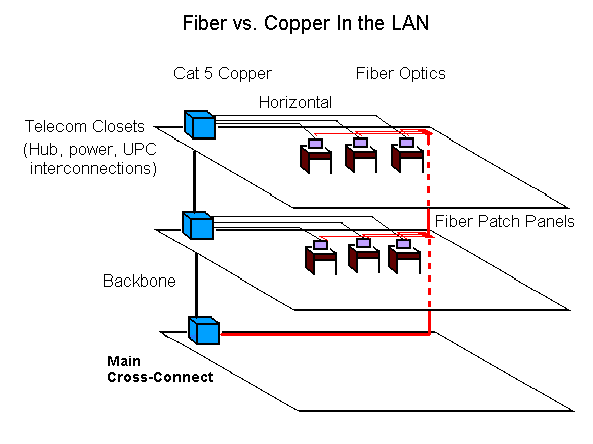

The Fiber Optic Association - Tech Topics
Is An All-Fiber LAN Really Cheaper Than Copper? (Here is a more general overview of fiber vs copper)
The answer, surprisingly, may be "yes" for new construction and major renovations. We know, "everybody knows fiber is too expensive," but that turns out to be a generalization that is out of date and comes from a "apples-to-oranges" comparison that favors the traditional copper architecture by simply replacing copper links with fiber and adding media converters.
The copper LAN layout as described in the EIA/TIA 568 standard (shown on the left of the drawing below), follows traditional telephone system designs from decades ago. It divides the LAN into "horizontal" cabling no longer than 90 meters connecting the desktop and a hub in a wiring closet. The horizontal distance limitation is the performance of the UTP cables. Every closet has a hub, which requires space, power, UPS and installation. Maybe even AC! Most closets have punchdowns, patchpanels and other passive hardware too.
The "horizontal" cabling connects to a "backbone," which by virtue of bandwidth and distance requirements, is mostly fiber optics already. The backbone connects all the hubs to a central communications facility, usually called a main telecom closet, where the complete LAN is managed.
When the "copperheads" (those who only think copper!) compare fiber-to-the-desk (FTTD) to copper, they show that a horizontal fiber cable plant may only be a few dollars more than Cat 5e UTP, but the network electronics for horizontal fiber cost a lot more, making fiber uneconomical.
That is a totally erroneous comparison, because with fiber you aren't limited to 90 meters. With fiber, you don't need horizontal and backbone links, you don't even need a telecom closet! You just need one link, a pair of fibers straight from the desktop to the main telecom closet (shown on the right of our drawing) You don't need conditioned power for a hub, backup power for the hub, a separate data ground, racks and space for all that or installation and maintenance labor and airc onditioning to get rid of all the heat. At most, with fiber you have an intermediate passive patch panel to connect desktop cables to the backbone cable and some extra (cheap!) fibers in the backbone cables.
So how much extra does the copper network cost? Different installations will yield different numbers, but in realistic comparisons, an all-fiber network usually comes out equal or cheaper!
What most people overlook is the cost of the wiring closet. Conditioned UPS power, data grounds, HVAC (even AC in winter because of all the heat generated by high speed electronics!) and floor space are very expensive. We estimate the following costs per closet:
Conditioned UPS Power $500-5000
Data Ground $500-1500
HVAC $250-5000 (+you nead year round AC!)
Floor space: $100-200/sq ft for 50-100 sq, ft. or more!
These costs generally exceed the extra cost of fiber equipment in a centralized fiber architecture.
Sound too good to be true? One of the most sophisticated LAN installations anywhere, the Getty Museum in Los Angeles, saved almost $4,000,000 by going to an all-fiber network. That's correct - FOUR MILLION DOLLARS! According to a Corning presentation at a recent 3M seminar, with UTP, they would have had to build 55 telecom closets in the museum, with hubs, power, etc. at a cost of $73,000 per closet. With an all-fiber network, they needed only one closet, saving an incredible amount of money (not to mention floor space for artwork, researchers, etc.)
Another big issue in LANs is reliability. We all know about fiber's immunity to electrical noise. But with an all-fiber network, you have only half as many electronic parts to worry about, because you get rid of all the hubs. That means there are only half as many pieces of equipment to fail, so the all-fiber network should be twice as reliable. And since all the master electronics is in one space, it's much easier to manage and troubleshoot.
Now we have established fiber's economic superiority, we don't even have to point out how fiber gives you a big advantage in upgrading too, instead of the relentless push to upgrade UTP installations every couple of years(but we did anyway!)
For all the 568 standards "wonks", the EIA/TIA 568 committee has recently issued TSB-72 which recognizes a centralized fiber optic network solution. It offers a simple, reasonable solution for an all-fiber network if you ignore the fact that they just don't seem to understand that fiber doesn't need the "horizontal" and "backbone" nomenclature. But you can tell you customers that an all-fiber network meets the "568" standard. And it may save them lots of money!
The Fiber Optic Association - Tech Topics
(C) 2002-5, The Fiber Optic Association, Inc.
More detailed information can be found on the FOA Online Reference Guide.
Return To The FOA Home Page
Return To FOA Tech Topics